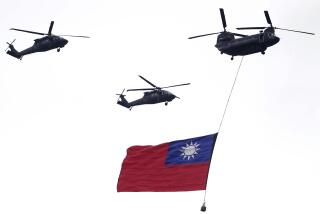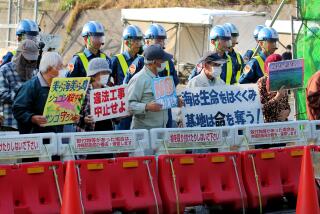Anti-Japan protests in China spread to more cities
BEIJING â Anti-Japan rallies spread to dozens more Chinese cities Sunday, as thousands of people demonstrated against the Japanese governmentâs plan to buy several uninhabited islands near Taiwan that China also claims. Protesters marched in front of diplomatic compounds, attacked Japanese businesses and burned Japanese flags.
In the southern city of Guangzhou, demonstrators stormed into the first two floors of a complex that houses the Japanese Consulate, breaking windows in a hotel and smashing a vehicle. In nearby Shenzhen, police fired tear gas and used a water cannon to disperse marchers. Japanese factories, grocery shops, restaurants and car dealerships were reported damaged in a number of cities, including Qingdao.
In Beijing, more than 1,000 marchers waving flags and carrying banners gathered for a second straight day in front of the Japanese Embassy, hurling water bottles at the building and chanting slogans such as âKnock down the little Japanese,â âLong live the Peopleâs Republic of Chinaâ and âChina will prevail.â
Hundreds of police and security officers, some holding riot shields, lined the protest route. But generally they appeared relaxed, calmly guiding the marchers back and forth past the embassy as a helicopter buzzed overhead. Scores of neighborhood watch volunteers, many of them senior citizens with red armbands, also patrolled the area.
On a nearby commercial street, Japanese restaurants were shuttered, with some hiding their signs behind tarps. Others hung Chinese flags and banners in front of their stores.
âThe Diaoyu islands themselves are not so important, but I do think Japan is trying to bully China,â said an 18-year-old university student surnamed Wen who came to watch the protest but not participate. âStill, I feel bad about these restaurants because it is Chinese people who work in them.â
Tensions have been rising since Japanâs government announced a plan last week to purchase three of what it calls the Senkaku islands from the Japanese family that has controlled them for decades. China has protested the move at the United Nations and sent vessels to the area in an expression of force. Taiwan, which also claims the island chain, has also sent ships to nearby waters.
Japanese Prime Minister Yoshihiko Noda, speaking Sunday on a talk show on national broadcaster NHK, called on China to ensure the safety of Japanese citizens and businesses in the country. The Japanese Consulate in Shanghai has reported that a number of Japanese have been harassed in recent days, including one who had a bowl of hot noodles thrown at him and another who was kicked on the street. The consulate urged citizens to not take taxis alone or speak loudly in Japanese while in public.
The protests are expected to continue at least through Tuesday, when China will mark the anniversary of an incident in 1931 that began Japanâs 14-year occupation of portions of the mainland.
The dispute brought a warning from U.S. Defense Secretary Leon E. Panetta that it could lead to a regional conflict. âI am concerned that these countries engage in provocations of one kind or another over these various islands that it raises the possibility that a misjudgment on one side or the other could result in violence,â Panetta told reporters traveling with him to Asia aboard an Air Force jet.
Panetta arrived in Tokyo on Sunday at the start of a weeklong trip to Asia that will also take him to China and New Zealand.
Large-scale protests of any kind are rare in China, though the government has allowed and even encouraged anti-Japan and anti-U.S. demonstrations in the past, particularly when such gatherings could help bolster its political or foreign policy objectives. Still, there is always the risk that such rallies could morph into outpourings of discontent with Chinese authorities themselves.
In a sign that the protests may be pushing officials toward the edge of their comfort zone, an opinion piece carried by the state-run New China News Agency on Sunday counseled that âwisdom is needed in the expression of patriotismâ and that âChinese people should be rational and obey the law when expressing patriotic feelings, and they should abstain from âsmashing and looting.ââ
A number of protesters in Shenzhen and Guangzhou had issues beyond the disputed islands, such as corruption and high housing prices, on their minds. One photo circulated on Weibo, Chinaâs Twitter-like microblog service, showed a man at a demonstration wearing a shirt reading, âIâm willing to feed the corrupted officials and become a housing slave, but I will never give up on the Diaoyu islands.â
Jessica Chen Weiss, an assistant professor of political science at Yale University who is writing a book on Chinese foreign policy and nationalist protests, said that although the government has taken pains to emphasize the island dispute, it would be a mistake to regard the protests as completely manufactured.
Weiss said the spread of Weibo and other technology has added more unpredictability into such situations for Chinaâs government and for outside observers trying to discern Beijingâs political objectives as it manages the gatherings.
âThe increasingly viral methods of organizing protests means the governmentâs task [in controlling the demonstrations] is harderâ once they start, she said. âAnd itâs harder to interpret Beijingâs intentions.â
Times staff writer David S. Cloud in Tokyo and Tommy Yang in The Timesâ Beijing bureau contributed to this report.
More to Read
Sign up for Essential California
The most important California stories and recommendations in your inbox every morning.
You may occasionally receive promotional content from the Los Angeles Times.











